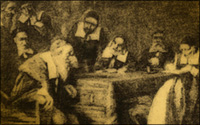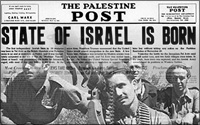
By the end of the 16th and the beginning of the 17th centuries, there were a number of instances of severe religious dissention among Jews. They were the harbingers of the future problems. Let us discuss two of them, both of which occurred in Amsterdam.
The first deals with a Jew by the name of Uriel Acosta (Uriel da Costa).
Uriel Acosta
Acosta’s father was a Marrano, and Acosta himself was born Catholic and baptized as a Catholic. He lived in Spain and Portugal. Many members of his family were high-ranking people in the local Roman Catholic Church. He received a traditional church education.
He was very bright, but from the earliest age he was a skeptic – and a particularly great skeptic in Roman Catholicism. So much so that his family feared for his life, because a Marrano or Marrano family that “lapsed” into Judaism would be burned at the stake by the Inquisition.
Due to this fear the family began to make arrangements in the late 1590s to move from Spain to the Netherlands. As a wealthy and influential family they were able to arrange for permission to leave. In the 1590s, we already find the Acosta family in Holland and Amsterdam.
There — as did countless other Marrano families — they officially reestablished their Judaism. They publicly stated in the synagogue that their conversion to Catholicism was null and void; they did not intend to be Christian at any time and were forced into it. Then they formally asked the Jewish community of Amsterdam to readmit them within the fold of Israel.
This was a fairly common occurrence in Amsterdam, where the estimates of the Spanish Portuguese community at the end of the 1500s and at the beginning of the 1600s were that 50% of the community was either Marranos or descendants of Marranos. The Acosta family was accepted, welcomed and treated with respect.
Uriel, who had changed his name from Gabriel, attempted to become a scholar in Judaism. Here one sees a problem that existed throughout this period of time: the Marranos really knew next to nothing about Judaism. Acosta’s version of Judaism was pure fantasy. It denied the immortality of the soul. It assumed that all the observances and commandments were merely customs and rituals. They were beautiful, but had no divinity to them.
He also harbored another misconception. To him the Jewish people were the perfect people.
Acosta could not come to grips with the fact that the Jews in Amsterdam exhibited the problems that exist in Jews and in non-Jews throughout the world. He saw greed and avarice. He saw political exploitation. He saw cheating.
An outspoken person, he made comments in the synagogue and in the Jewish street, and then finally he wrote them in a book in Latin. The book he exposed his beliefs, which did not resemble Judaism. There was very little ground left for him to be a Jew.
He still might have gotten away with it, especially since it was written in Latin, but in the second half of the book he caricatured certain leading members of the Jewish community of Amsterdam for their greed, avarice and bad habits. He included a two-page criticism about picking one’s nose.
This did not endear Acosta to the community. They had, after all, accepted him back into the community as a full-fledged Jew despite his family’s baptism. In 1598, the rabbinate of Amsterdam issued a ban of the excommunication against him.
Now, he had nowhere to go. He wandered from town to town in Europe for a long period of time, perhaps six or seven years. It embittered him. Finally, he came back to Amsterdam and said he would recant everything, and they took off the ban of excommunication.
Not surprisingly, he acted the part of a good Jew for about six months, and then he started again speaking and writing what he really thought. He wrote another pamphlet that was very negative about Judaism. They, of course, excommunicated him again. By now he was probably mentally unbalanced.
Even though Acosta was a heretic who was hypercritical and mentally unbalanced, even though virtually everything he wrote about Judaism was wrong, he eventually attracted a following in the Jewish community, especially the community in Amsterdam. Before the issue could really come to a head, however, Acosta died.
Nevertheless, this incident would serve as the prelude to an even more famous and infamous incident that happened 30 years later in the same community.
Baruch Spinoza
Baruch Spinoza did not come from a Marrano family. He was born to a Jewish family in Amsterdam in 1632. By the 1640s he had already earned his reputation as a brilliant student.
He had attended the yeshiva in Amsterdam. During an interlude in his schedule, Spinoza taught himself Latin and Greek and became a scholar in in philosophy and mathematics. He obviously possessed an unusual mind. He also became an excellent writer and wrote in many languages. However, his ideas were not very Jewish.
Today, Spinoza is described as a pantheist, but he was really more of a deist. In either event, his vision of God was certainly not the Jewish vision of God. It was another religion entirely. As a consequence, the leaders of the community excommunicated him.
Historians debate whether or not the world would know about Spinoza had he not been excommunicated. Was he really a great a philosopher? Was his contribution to philosophy substantial? Would his legacy have been as great? No one can say for sure. However, it is certain that the excommunication cemented his fame.
The Rise of Capitalism
The 17th century marks the beginning of the modern world with its great exploration and colonial empires. The world was undergoing fundamental changes. The king of England was executed. The divine right of kings was successfully challenged. The beginnings of the democratic system were taking root.
Perhaps most of all, a new world economy emerged – one in which the Jews were extremely influential bringing about.
Max Weber, in his classic text on economic sociology, Protestantism and the Rise of Capitalism, argued that when Luther mounted the Protestant revolution he unwittingly gave freedom to the marketplace. In breaking the power of the Church, he broke feudalism, the monopoly of the guilds and thereby unleashed a new economic reality, allowing the marketplace to come into existence, which led to the rise of capitalism, industrialism as well as the technological revolution which completely changed the face of the civilization.
This monumental change was part and parcel of the Jewish experience. Jews found it difficult to hold high positions publicly, but behind the scenes they were extremely influential. In fact, it was the Jewish influence that transformed tiny Holland into a ranking colonial empire.
Jews made Rotterdam and Amsterdam the main ports of the continent. The Jews moved down to Antwerp, and established the diamond trade in Amsterdam, which was the first place in Europe that had a diamond trade. And Jews made deals all over Europe through other Jews.
That was good and it was bad. On one hand, it was good for business — not just Jewish business. On the other hand, in a sense, it can be said that the Jews gave birth to the idea of an international conspiracy by Jews. There was no conspiracy and it was not intentional – but the prevalence of Jews in trade could give cause to those who felt left out or who had anti-Semitic leanings that the Jews were conspiring to take control of the world.
The Long Arm of the Inquisition
An important event transpired which marks the end of the 16th century and the beginning of the 17th century. Pope Paul IV was one of the most anti-Semitic radically anti-Jewish popes in the history of the papacy. In 1556, his fanatical anti-Semitism came to the fore.
In Ancona, a port city in Italy, a large number of Marranos who had escaped from Spain did a brisk business with merchants in the cities of Venice and Florence. They were extremely skillful merchants. They were too good, in fact. Their success aroused the enmity and jealousy of their non-Jewish neighbors.
As a result, their enemies came to the pope and asked him how he could tolerate the presence of Marranos in his papal state. They had escaped Spain, thrown away their Roman Catholicism and proclaimed themselves Jewish — and yet were living under the protection of the pope! The pope did not need much of an excuse and decided to take immediate action against the Jewish community.
However, Florence and Venice needed the Jewish merchants. Therefore, the cardinals from Florence and Venice told the pope to ignore it. However, this pope was a “true believer.” There is a short but highly recommended book called The True Believer by Eric Hoffer. It is a study of religious fanaticism throughout the ages. It shows what can happen if one does not see things with any sort of perspective. Pope Paul IV was fanatic. He felt certain that he was going to gain heaven on the backs of these Jews in Ancona. Consequently, he sent in the Inquisition there.
They found 51 Jews who had converted to Roman Catholicism but had since “relapsed” into Judaism, which was a capital crime punishable by execution by burning at the stake. Twenty-six Jews who could not withstand the trial were re-baptized. They were sent to the island of Malta for life imprisonment and hard labor. Interestingly, the Jews pirated the ship on the way to Malta and never served their sentence. However, 25 were burned at the stake. The execution took place in the square in the city.
This incident shook up the Jewish people very badly. All of the Marranos – even those in Amsterdam — were frightened. They had thought that as long as they were out in Spain and Portugal they were beyond the reach of the Inquisition. Now they knew otherwise.
The Jews tried every way possible — through bribery and influence — to somehow quench the ardor of the pope. The only thing that helped was that he died. But before then, this raised a question. The Jews in Amsterdam wanted to fight back and boycott the port of Ancona. They would take their business elsewhere. It is reminiscent of what would happen before the Second World War. In the 1930s, after Hitler came to power and started issuing anti-Semitic decrees, there was a tremendous debate among the Jews whether or not to boycott Germany. Some thought it was a great idea; others thought it was terrible.
A similar debate now raged between Jews about doing business with the port of Ancona. Some said to boycott it while others said not to. A boycott was in essence an open declaration of war between Christians and Jews — and the Jews certainly had more to lose. There were still Jews living in Ancona, they argued. This pope would not live forever. The anger will blow over.
The side calling for a boycott prevailed, but the attempt to enforce it failed, because a boycott requires almost universal agreement. Since there were Jews who felt very strongly that the boycott should not take place, that it was counterproductive and harmed Jewish interests instead of helping them, there was no true consensus. The whole boycott campaign fell apart and the Jewish community of Ancona remained active as a trading center – and continued until the Second World War.
The 1600s mark the coming of the modern era. Fundamental changes were taking place. The Jews would not only be active in bringing it about, but, perhaps more than any other people, they looked forward and adjusted to it in advance.











